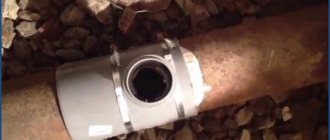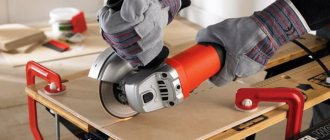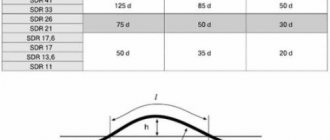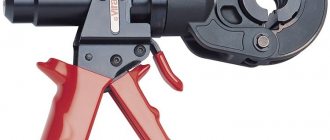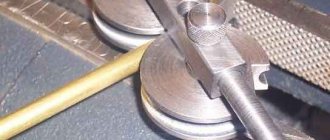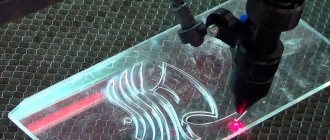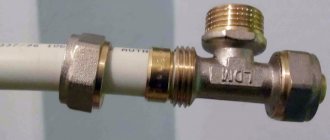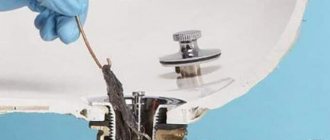Required Tools
In order to cut the pipe straight along, it is very important to choose the right tool. The quality of work largely depends on it. So, let's look at the most suitable tools for working on a pipe:
- Bracelet with a hole. This equipment is designed specifically for making the cut. It is convenient and allows you to get the job done efficiently;
- Jigsaw. Allows you to make an even and neat cut. In this case, you do not have to purchase special equipment;
- File. And in this case, the cut is smooth and of high quality. However, working with both a file and a jigsaw takes quite a lot of time;
- Bulgarian. The tool allows you to get the job done quickly and relatively easily. However, there are also disadvantages. The cut is not even enough.
You can choose the tool that suits you best, or that you already have in your workshop.
Completing of the work
First, let's look at how to cut a pipe lengthwise using a bracelet with a slot. The work is done simply. You need to put the device with the slot up on the structure, and then, holding the structure tightly, make an incision. Then the bracelet is removed, a saw is taken, and placed in the hole of the device. The bracelet is attached with the slot facing down. After this, you can cut the pipe lengthwise evenly.
You can use another method. The pipe is placed on a smooth surface. Then it is firmly fixed. The structure must be secured on both sides. This can be done using massive corners. For reliability, it is recommended to secure the structure over its entire surface using a block. This way you can prevent it from rotating while doing work. Then the peaks are marked. An outline is made using a string dipped in ink. The size of the circle is measured. A template is made, which is a thread half a circle long. It is fixed on nails. From the line drawn earlier, points on the other edge of the structure are indicated. Then you can cut the pipe lengthwise. This can be done using any of the tools described earlier.
There is a third method. Two points on the surface are indicated. The thread is pulled in accordance with them. To clearly mark the line and prevent it from becoming clogged with construction debris, you can secure paper tape in this place. Its edge should correspond to the edge of the stretched rope. It is this edge that marks the place where the incision is made. After this, you can cut the pipe lengthwise. If you are making a cut using a hacksaw blade on metal surfaces, for ease of work it is recommended to attach a rag or other material to the edge of the blade. They will allow you to more securely grip the canvas with your hands.
To make a straight cut on a pipe, there are many other methods invented by folk craftsmen. Each method has its pros and cons. The choice is ultimately yours. You can find out even more options for performing this work by viewing additional materials: photos, videos.
Source
45 degree cutting
One particular example of such a situation is the need to cut a metal pipe at an angle of 45 degrees. Such cutting of material is often required when laying water pipes or heating systems. In this case, you have to deal with steel pipes.
For these purposes, conventional cylindrical pipes are usually used. If we are talking about the installation of some kind of metal structures, then profile pipes of rectangular or square cross-section are more often used.
The main problem here is that in order for the elements to be connected to coincide, the cut must be as smooth as possible, which means that especially close attention should be paid to marking the material.
In cases where cutting at an angle is required, a simple square sheet of paper can be used as a marking template. It must be folded strictly diagonally, and then wrapped around the pipe with the template.
In this case, it is necessary to carefully ensure that the side of the sheet, which is located closer to the end of the pipe, is perpendicular to its central axis. Next, using marking material, a series of dotted lines is applied and after the marking is completed along the entire circumference, the template can be removed.
Photo of the template for cutting pipes - side view
Larger pipe blank
Marking a 45 cut using a template
If you have to cut a profile pipe, then it is advisable to make a special template from the same pipe, but with a larger cross-section. In this case, you will only have to use the measuring devices once. To apply markings you will need to use a protractor or a construction square.
After sawing off the template, the pipes to be cut can simply be inserted into it and marked. This approach will significantly save work time and cutting a profile pipe at 45 degrees will be convenient.
As for what to use when carrying out work, you should choose the most suitable and familiar one. This can be a simple hacksaw for metal, or a grinder with an installed cutting disc.
Hacksaw/Back Saw
This is what a typical hacksaw looks like
A hacksaw or back saw are the most common methods for cutting PVC pipe, as most people already have one of these in their toolbox or garage. Hacksaws and back saws work well, but they are time-consuming and can result in extra work to remove burrs from the edges of the cut PVC pipe. A hacksaw or back saw is an ideal tool if you only need to cut one or a few pieces of pipe. Back saws usually come with a miter box and can be used together to make straight, even cuts.
How to cut a profile pipe lengthwise or crosswise: marking and cutting methods
In households, profile pipes are widely used in the manufacture of greenhouses, greenhouses, canopies to protect vehicles from precipitation and other structures. When working with this material, it is useful to know how to cut a profile pipe along a line or crosswise with the most accurate angle.
Among the large number of construction metal cutting tools, the leader in speed, ease of cutting and efficiency is the angle grinder (grinder), which is often present in the tool kit of any home craftsman. To cut a profile steel pipe using a grinder, you will need a regular metal disc and strict adherence to safety rules - breaking the disc into segments at high rotation speeds can lead to serious injuries.
Fig.1 Profile pipes in the household
How to cut a profile pipe straight across
Most often in households, a rectangular or square pipe metal profile with a wall thickness of no more than 3 mm is used, and cutting into separate sections is necessary when carrying out work on assembling welded frames.
To cut a pipe correctly, additional devices are used to mark and mark the cutting line; some of the devices serve as a support edge for the cutting disk.
The nuances of working with a rectangular section
Rectangular workpieces are much easier to cut lengthwise and crosswise at any angles than cylindrical elements, which are difficult to hold stationary on a flat surface. Transverse cutting of workpieces at any angle does not present any particular difficulties - the line of the required angular slope is drawn on the side edge and always coincides with the calculated one (round elements require the use of special patterns, calculated on a computer, to align their edges at an angle other than a straight line).
The thickness of the walls of a metal profile when used in households rarely exceeds 5 mm - it is easy to cut using an angle grinder with any metal disc.
Rice. 2 Types of transverse marking methods
What tool is used
As noted above, the main tool for cutting metal parts at home is an angle grinder; if you don’t have one, you can use a hand-held hacksaw or a jigsaw, which can also cut metal materials with a special diamond-coated blade.
For cutting with a grinder, cut-off electrocorundum discs are used, which are not intended for grinding operations. As an auxiliary tool, a tape measure, a metal ruler, various types of clamps, pencils and markers for marking will be useful.
Paper pattern for pipe
Using a paper sheet is a simple method of marking a rectangular or square profile for precise cutting at an angle of 90 or 45 degrees towards its axis.
To make markings for cross cutting at an angle of 90 degrees, take a sheet of paper and wrap it around the pipe until the edges line up exactly, after which they are glued together. With this method, the cutting line is very clearly visible, unlike drawing it with a pencil or marker along the edge of the template.
After this, the profile is cut along the template edge alternately from all sides, trying to avoid complete cutting of the finishing sections - this can lead to the disk hitting sharp corners and its destruction.
A sheet of paper can also be used to mark the side walls of rectangular or square pipes. To do this, the paper sheet is folded diagonally, and the resulting 45-degree angle is applied to the side walls and the appropriate markings are made. To ensure that the side lines are at the same level, an acute angle is applied to the transverse line placed at an angle of 90 degrees to the axis, which is previously applied in the above manner.
Rice. 3 Using a steel template
Miter box for cutting pipes
It is very convenient to cut a profile pipe using a special template, which is an analogue of a construction miter box for cutting building materials at different angles.
To do this, using the above or another method, a metal template is made from a piece of profile pipe cut along the length; it can be designed to obtain a right angle or an angle of 45 degrees.
To cut a metal profile, apply a template to it and draw a line with a scriber, along which a cut is then made. In other cases, the template is held and a grinder is used to draw a line along the surface of the workpiece, trying to avoid strong pressing of the side surface of the disk against the attached metal template. Then the template is removed and cutting continues along a clearly visible depression on the edges of the workpiece.
Using a template, you can get a very straight cut line if you do not hold it manually, but secure it to the workpiece using clamps or mounting bolts.
To make your own fasteners, drill a hole in the side surface of the U-shaped plate of the template and weld a union nut at this point from the outside into which the bolt is screwed.
To secure the template, place it on the part to be cut and screw in the bolt, pressing the template surface against the workpiece, then use a grinder with a metal disc to make a cut, lightly touching the guide edge.
Scissor pipe cutter
Scissors are suitable for PVC no thicker than an inch thick.
PVC pipe cutters are inexpensive and easy to use. They are available at most hardware stores or home improvement centers in the plumbing section. They are, however, limited in their cutting ability and can add strain to your hands as they are ideal for smaller pipes. Plastic pipe cutters should only be used on PVC that is 1 inch thick or less.
Ratchet Pipe Cutter
The power saw is ideal for cutting large quantities of PVC pipes. Power saws, however, are expensive. If you already have one or have access to one and know how to use it safely, you can use an existing wooden blade to cut PVC pipe without purchasing a special blade. Be sure to read and understand the instructions that came with your miter saw.
Source
Design features of pipe cutters
Manufacturers make hand-held mechanical and electrical cutters for precise cutting of polypropylene products.
Cordless polypropylene pipe cutter
When choosing a tool, the following are taken into account:
- Scope of upcoming work.
- Blade quality. It must be created from alloy steel.
- Minimum and maximum diameter of cut pipes.
Cutting equipment is usually built with a metal body. Aluminum models are preferred. Devices with a steel body are heavy.
Therefore, they are less convenient to use. Moreover, when cutting PP pipes, you do not need to put in much effort. Aluminum housings can withstand the loads created perfectly.
Models are available in which the cutting parts can be changed. For large volumes of work, this type of tool is used. If it is not possible to change the blade, you will have to buy a new device. This nuance is not taken into account during one-time work.
Guillotine
This type of tool is characterized by its simple design and ability to accurately cut straight pipe parts. Manual and electrically driven guillotine models are available. The design of the equipment includes a blade that is strictly perpendicular to the pipe.
Most hand-held devices are capable of cutting products with a diameter of up to 70 mm. A tool is also produced that allows you to work with parts with a cross-section of 100-150 mm.
This range is quite enough to install plumbing and heating in an apartment or cottage. Industrial models allow you to cut larger diameter pipes.
The guillotine pipe cutter consists of the following main parts:
- sharp blade usually coated with Teflon;
- bottom-opening pipe element clamp;
- a handle with a rod that allows you to create smoothly increasing pressure.
The guillotine tool is not designed to perform work in an accelerated manner. The reason for this is the rod, which after each cut has to be unscrewed in the opposite direction.
Ratchet
Such devices are structurally similar to scissors. The devices have two handles and one blade. The design also includes a semicircular stop for placing the pipe to be cut.
The ratchet mechanism is a ratchet. It moves the knife smoothly with minimal effort. Using such a tool, pipes with a diameter of 15 to 30 mm are usually cut. If the blade is dull, the polypropylene product will wrinkle.
If you press sharply on the ratchet mechanism, deformation of the walls of the pipe parts may occur. Therefore, you need to work with the tool as carefully as possible. Also keep the pipe cutter strictly perpendicular to the axis.
Even a slight deviation to the side will result in an oblique cut. In this case, the end has to be ground. If it is also jammed, then a calibrator is additionally used to straighten it out.
Ratchet pipe cutters are also available in a pistol version. Such models allow you to obtain a more even cut with even less effort.
Their design contains a spring that returns the knife to its original position. Pistol ratchet pipe cutters are suitable for cutting thick, hard-walled pipe parts.
Roller
The devices are made in the form of a hook, inside of which there is one or more movable wheels. The pipe to be cut is placed on the rollers.
How to cut a profile pipe lengthwise - cutting technology
If cross-cutting a profile does not cause any particular difficulties, then a longitudinal cut, which is necessary for some work in the household, is more complex due to its length.
One of the problems when carrying it out is the accuracy of the markings; to apply it in the center or at another point of the cut edge, marks are placed along the entire length at the same distance from the side wall and then they are connected with a pencil, marker or scriber, using an even corner, construction paper, as a guide. usually a level, a profile from drywall.
Rice. 6 Cutting a pipe lengthwise along a guide angle
In order to cut a metal profile in the longitudinal direction, they drive the angle grinder along the line, gradually cutting a through hole - the method is not very accurate, the tool has to be held suspended without support.
A more convenient way to qualitatively cut a workpiece longitudinally is to use auxiliary supports in the form of a metal corner or even straight plates. To do this, the corner is attached to the surface of the workpiece using clamps and the grinder is guided along its side edge; if the length of the template corner is small, it is unscrewed and moved further to a new place, after which cutting is resumed.
The second way to obtain an even longitudinal cut line is to have a grinder rigidly mounted on a machine or table in a side position. The workpiece being cut is moved along guides, brought to the rotating disk of an angle grinder (the operating principle is reminiscent of an electric tile cutter), the straightness of the resulting line is determined by the rigidity and length of the supporting elements.
Rice. 7 Securing the angle grinder for longitudinal cutting
To obtain the specified sizes and configurations of profile pipes in the household, cutting is used using an angle grinder and inexpensive cutting corundum discs. To get an even and accurate cutting line, it is better to use support guides or homemade steel templates that set the desired angle.
When installing various structures, it is sometimes necessary to cut the pipe lengthwise. This work is not as simple as it seems at first glance. In order for the design to be of high quality and reliable, this work must be done smoothly. Only in this case will the welding line be correct and accurate.
Mechanical or electrical
To install a PP heating or water supply system, experts recommend a manual pipe cutter. It is simpler in design.
A manual one costs less compared to an electric tool. The second one is more often used by professionals when performing a large amount of work. Electrically driven devices allow you to get straighter ends with minimal effort and time.
Manual pipe cutters are compact. Large electric models are sometimes impossible to use for inserting into an existing pipeline. In such cases, polypropylene pipe scissors are always used.
One option is a device with a battery. The weight of such a tool is from 1.5 to 2 kg. The presence of a battery allows you to freely use the equipment without being tied to an electrical outlet. A fully charged battery will last for one day.
How not to cut polypropylene pipes
To ensure smooth edges of straight pipe products, cutting is not recommended:
- hacksaw for wood or metal;
- with an electric jigsaw even at low speed;
- an electric drill with a disk attachment from the inner surface of the pipe.
If you use such devices, the edges will turn out torn. They will have to be carefully cleaned and aligned before soldering to create a reliable connection.
The grinder is also not suitable for cutting polypropylene. The reason for this is the high rotation speed of the disk element. Because of this, the material heats up and begins to melt.
You should also not use cutting devices for rolled metal. They will tear polypropylene as their knives are not designed to work with polymer materials.
How to cut thin-walled pipes
Another type of pipe is thin-walled products. They are usually made from non-ferrous metals such as aluminum or copper. Cutting thin-walled pipes is more difficult, since the probability of element deformation is high. In this case, you can use some kind of filler, such as sifted sand.
As a tool, you can use a grinder, a hacksaw or a special machine. It all depends on the specific situation.
Cutting metal pipes is a rather labor-intensive, but completely do-it-yourself process. At the same time, working with round pipes is not fundamentally different from cutting a profile pipe. The main thing to remember is that when performing work you must follow safety rules.
How to cut plastic pipes
When installing various pipelines, plastic pipes are increasingly replacing steel ones. This is facilitated by factors such as:
- a wide variety of products made from different types of plastic;
- high resistance of plastic to corrosion and overgrowing of walls with limescale;
- the lightness of plastic pipes, which greatly facilitates the installation of pipelines;
- lower cost of plastic compared to metal pipes, significantly reducing the estimated cost of laying pipelines;
- long service life.
Therefore, plastic pipes are widely used in both industrial and private housing construction.
What tool can be used to cut plastic pipes
Considering that the people in our country are artisans, then they manage to use the most unimaginable means at hand to cut pipes. But you should not think that such cutting contributes to the good quality of the future pipeline. Therefore, we will consider the tools that allow you to cut plastic pipes with the highest quality:
- hacksaw for metal;
- self-sharpening knife (with fine teeth);
- scissors for cutting plastic pipes;
- roller type pipe cutter;
- battery pipe cutter;
- guillotine pipe cutter.
Cutting pipes with a hacksaw or a knife should not be considered seriously, since their use leads to the end of the pipe being frayed and burrs forming, which must be eliminated using sandpaper or stripping with a knife.
In any case, the quality of the cut suffers. These methods can be used for single cuts. If the pipeline has a complex configuration and many connections of individual sections, then it is better not to use these tools. Pipe shears are mainly used for cutting plastic pipes.
The sharpened blade of the knife is attached to only one side of the tool.
In place of the second blade there is a fairly wide base with a slot designed to receive a cutting plate. Working with such scissors is carried out exclusively by human muscular strength. Between the handles of the scissors there is a rounded toothed rack, which, after closing the handles of the scissors, pushes the blade towards the base. The pipe cutting process occurs as follows:
- a clearly visible mark is placed on the surface of the pipe, marking the place of the cut;
- the base is placed on top of this mark, controlling its position through the slot in the base;
- then, applying force, they cut into the pipe and, gradually increasing the force, make the final cut of the pipe.
How to cut a pipe evenly with a grinder at 45 and 90 degrees | Cutting methods
When working with construction or plumbing tasks, you need to know how to cut a pipe evenly with a grinder. In this article we will look at quick and easy ways of how to properly cut a pipe with a grinder so that the result is perfect.
Cutting pipe at an angle of 45 and 90 degrees
If you need to cut a pipe at an angle of 45 degrees, which is often required when laying water and heating pipes. Often steel and cast iron pipes that have a cylindrical shape are used. In installation work, rectangular or profile pipes are used. However, you should cut the pipe correctly with a grinder so that you can easily connect it later. Therefore, you should carefully mark the pipe.
Some craftsmen try to mark the cutting area using a tape measure, but we warn you that the result will most likely be negative. And for a positive result, consider the following recommendation from professionals.
Take a sheet of paper or cardboard, preferably A4, fold it diagonally and wrap it around the pipe where you plan to make an even cut. The edges of the paper must be absolutely aligned with each other. And the side of the paper that is closer to the end of the pipe was perpendicular to the axis. Then mark a cutting line in a circle.
If you need to cut exactly at an angle of 90 degrees, then solve the problem quickly using paper or masking tape. Wrap it around the pipe so that the ends match. Make an even mark and saw off.
How to cut a profile pipe evenly?
Craftsmen advise using a square when cutting a profile pipe. To do this, apply the square to the sides one by one, and turn and apply marks with smooth movements. After the steps, secure the pipe and cut. Prepare yourself a template that will be useful in the future and will save time. It is better to carry out the action with a grinder, so the cut will be smoother.
How to cut a cast iron pipe?
When working with cast iron pipe, keep in mind that it is a fragile material. Therefore, we will find a way to cut such metal without damage.
Before starting work, make notes for the cut, as you would when working with steel pipes. Place a wooden beam for support. Run a grinder around the circumference of the pipe, making small cuts. Then take the chisels, insert them into the groove and hit them hard with a hammer. Please note that Bakelite-based cutting discs are used to cut cast iron pipes.
If you don’t have a grinder at hand to cut a cast-iron sewer pipe or other purposes, use a hacksaw, chisels or special pipe cutters.
How to cut a gas pipe?
Cutting a gas pipe is a dangerous action, so it is best to leave it to professionals. But if you are confident in your abilities, then use a grinder, welding, hacksaw, or gas welding to cut metal.
Trimming instructions:
- Before work, turn off the gas supply riser. Then release the rest of the gas from the pipe. To do this, light the gas in the burners and wait for it to go out.
- After these steps, cut. Using a welding method, the metal base burns when exposed to high temperature. The result is fast and effective. But remember that cutting or rooting gas pipes again requires experience.
Other Plastic Pipe Cutting Tools
They are rarely used when there is no pipe cutter at hand:
- Grinder – to cut pipes you will need a metal cutting disc. The main point when working with an angle grinder is to accurately regulate the force; you cannot put too much pressure on the tool.
- A jigsaw is the most convenient way in the absence of special scissors. There is a high probability of getting an oblique cut, so for greater accuracy during operation the pipe must be turned several times.
What is strictly not recommended for cutting pipes:
- Band saw - its blade moves too slowly and if it is not sharp enough, there is a high probability of damage to the internal diameter of the pipe, which leads to chips and cracks.
- Circular machine. Because plastic pipes are flexible, pushing them into the machine often causes the pipe to dislodge and impact, which is dangerous for the person making the cut.
How to cut polypropylene pipes
We have already written about polypropylene pipes in this article. the pipe itself , as well as the fittings and connections, cost a significant penny for them. Because they are very common, I will try to tell you as much about them as possible. And now it’s an easy article to learn how to cut polypropylene pipes. It seems like an easy question, but not many newbies know about it………
How to cut a pipe straight? review of pipe cutters
Unlike iron and metal-plastic pipes, which can be cut with a hacksaw, polypropylene pipes are much softer. And cutting them with a hacksaw is, excuse me for the expression, “pure perversion.” But if you don’t have anything on hand, you can also cut with a hacksaw. In general, to be honest, you can cut such pipes with anything, even with a knife, it’s plastic. BUT there is a small minus: cutting polypropylene with a hacksaw is acceptable. The whole point is that at the place of the cut there will be shavings that remain in the pipe and will interfere with the water clot, and this is no longer good.
Therefore, when cutting polypropylene pipes, I advise you to use special scissors.
Scissors for cutting polypropylene, come complete with many soldering irons for polypropylene pipes. The scissors have a special, very sharp knife that is located on top, as well as a lower holder where the pipe lies.
We simply mark the appropriate pipe size, put it in scissors and cut off the appropriate pipe size. It's simple. It must be said that polypropylene is not at all difficult to cut.
After such cutting, there are no burrs or crumbs left, only a very smooth surface, you can solder right away.
Cut polypropylene with scissors, if you don’t have them, buy them, they are not cheap, 100 - 400 rubles, but they are worth it.
Other Plastic Pipe Cutting Tools
They are used occasionally, when there is no pipe cutter at hand:
- Grinder – to cut pipes you will need a metal cutting disc. The main point when working with an angle grinder is to clearly regulate the force; you cannot put too much pressure on the tool.
- A jigsaw is a more successful method in the absence of special scissors. There is a great chance of getting an oblique cut, so for greater accuracy during operation the pipe needs to be turned a couple of times.
What is strictly not recommended for cutting pipes:
- Band saw - its blade moves very slowly and if it is not sharp enough, there is a high possibility of damage to the internal diameter of the pipe, which leads to chips and cracks.
- Circular machine. Since plastic pipes are flexible, pushing them into the machine often causes the pipe to move and cause an impact, which is unsafe for the person making the cut.
Tools for processing pipe cuts
Bevel remover – designed to improve the quality of welding of plastic pipes.
It is used to remove the edge or top layer of plastic pipes along the diameter. On sale you can find chamfer removers of various designs designed to work with pipes of different diameters. When purchasing, you need to decide on the scope of work and pipe material. The tool comes with both manual and automatic feed. It allows you to adjust to the required pipe diameter and wall thickness.
Caliber – necessary for working with metal-plastic pipes. With its help, before soldering the pipes, the aluminum layer on the pipe cut is cleaned. In addition, the gauge allows you to remove burrs and cut irregularities, as well as, if necessary, chamfer.
If the pipe is slightly dented during cutting and the cut has acquired an oval shape, the calibrator will straighten the end, making it perfectly round again. A separate calibrator is required for each specific pipe diameter.
Source

